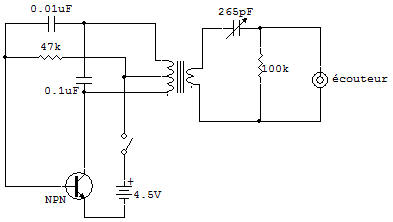
A Variable Capacitor

Back in Project Variable Resistor (potentiometer) and Diagram trace of a variable resistor we saw how a variable resistor works.
Since you've seen how different capacitances can affect circuit operation, you probably suspect that a variable capacitor exist. You're right - it's the Tuning Control. This Project will show you how a variable capacitor can affect the operation of an audio oscillator circuit.
When you finish the wiring connections, put the power ON. You'll hear sound from the Earphone.
Now adjust the Tuning Knob— what happens?
You heard the sound change. Look at the schematic for this Project carefully, notice where the variable capacitor is placed in the circuit. What property of the capacitor controls the operation of this circuit?
No, it isn't the ability to store and discharge electricity - it's the ability to let AC pass while blocking DC. AC is current that first flows in one direction and then the other. (Were you able to figure that out by yourself?)
This pattern repeats over and over many times a second. DC is current that flows only in one direction. (Remember those notes we asked you to make back in Project Capacitors in Series and Parallel, how close did you come to the right answer?)
Capacitors can pass AC because they charge and discharge each time the current reverses direction. In DC they simply charge and then accept no more current. It happens that the output of the oscillator circuit has some AC characteristics (although it actually isn't true AC). But it's close enough to AC so that we can Control the sound in the Earphone by adjusting the Tuning Control.
Is the Tuning Control linear like the Control (the variable resistor)?
Try the same graphing experiment you did in Project Diagram trace of a variable resistor and see.
